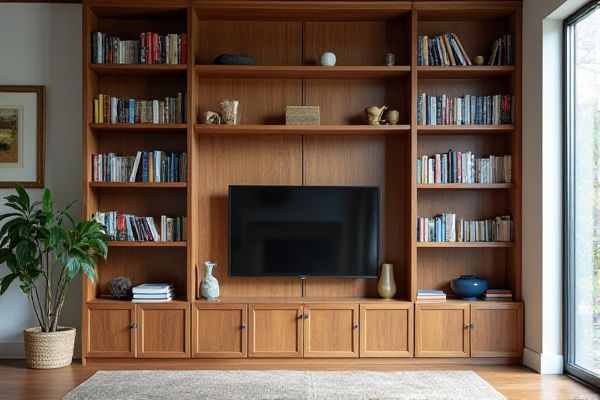
Open back bookshelf speakers offer a more natural, spacious sound by allowing rear sound waves to interact freely with the room, enhancing soundstage clarity. Closed back bookshelf speakers provide tighter bass and better isolation, ideal for minimizing sound leakage in your listening space; explore the rest of the article to find the best choice for your audio setup.
Table of Comparison
| Feature | Open Back Bookshelf | Closed Back Bookshelf |
|---|---|---|
| Design | Exposed rear, airy look | Solid rear panel, enclosed appearance |
| Light Flow | Allows natural light & air to pass | Blocks light, less air circulation |
| Wall Protection | No protection from scratches or marks | Protects wall from damage |
| Stability | Less rigid, depends on frame strength | More stable due to rear panel support |
| Weight | Lighter due to less material | Heavier, uses more wood or board |
| Customization | Easier to paint/wall-mount behind | Limited wall access after installation |
| Price | Generally more affordable | Usually costs more due to added material |
| Use Case | Ideal for open, airy rooms and displaying decor | Best for solid storage and formal settings |
Introduction to Bookshelf Speaker Designs
Bookshelf speakers come in two primary designs: open back and closed back, each influencing sound quality and room acoustics differently. Open back speakers allow sound to disperse from both the front and rear, creating a more natural, spacious audio experience but requiring careful room placement. Closed back speakers, with sealed enclosures, provide tighter bass response and reduce sound leakage, making them suitable for environments where precise sound control is essential for your listening setup.
Understanding Open Back Bookshelf Speakers
Open back bookshelf speakers feature grills or panels that allow sound to escape from the rear, creating a more natural and spacious audio experience with enhanced high-frequency dispersion. These speakers typically produce a wider soundstage and more accurate imaging compared to closed back designs, making them ideal for critical listening and detailed music appreciation. However, open back models require careful placement and room acoustics management to minimize sound reflections and ensure optimal performance.
Exploring Closed Back Bookshelf Speakers
Closed back bookshelf speakers offer enhanced bass response and reduced sound leakage, making them ideal for environments that require focused audio without disturbing others. Their sealed design provides tighter, more controlled low-frequency performance compared to open back models. These speakers excel in small to mid-sized rooms where clarity and impact are essential, delivering immersive sound with minimal interference from surrounding noise.
Sound Quality Differences: Open Back vs Closed Back
Open back bookshelf speakers deliver a more natural and spacious sound by allowing air and sound waves to flow freely, resulting in wider soundstage and improved imaging. Closed back bookshelf speakers provide tighter bass response and better isolation by enclosing the rear of the speaker, minimizing sound leakage and room interaction. Sound quality differences between open back and closed back designs primarily affect acoustic transparency and bass control, influencing the listening environment's overall clarity and immersion.
Room Placement and Acoustic Implications
Open back bookshelf speakers allow sound to disperse through the rear, making them ideal for placement away from walls to prevent unwanted reflections and enhance soundstage openness. Closed back bookshelf speakers feature sealed enclosures that direct sound forward, allowing placement closer to walls or corners with reduced risk of bass distortion and increased bass response control. Understanding your room setup and acoustic needs helps you choose speakers that optimize clarity and spatial imaging for your listening environment.
Bass Response and Frequency Range
Open back bookshelf speakers generally provide a more natural and spacious sound, but their bass response tends to be less pronounced and less controlled compared to closed back models. Closed back bookshelf speakers typically offer enhanced bass extension and tighter low-frequency performance due to their sealed enclosure design, which reduces sound leakage and resonance. The frequency range in closed back speakers often extends lower, delivering deeper bass, while open back designs emphasize midrange clarity at the expense of bass depth.
Noise Isolation and Sound Leakage
Closed back bookshelf speakers offer superior noise isolation due to their sealed design, effectively minimizing sound leakage and preventing audio bleed into adjacent rooms. Open back bookshelf speakers allow sound to disperse from both the front and rear, resulting in increased sound leakage and reduced isolation, making them less ideal for environments requiring quiet. For critical listening or shared spaces, closed back models provide enhanced acoustic control and focused sound delivery.
Use Cases: Which Design Suits Your Needs?
Open back bookshelf designs are ideal for displaying decorative items and promoting airflow, making them perfect for living rooms or offices where aesthetics and ventilation matter. Closed back bookshelves offer better wall protection and prevent dust accumulation, suited for storing valuable books or items in bedrooms and study areas. Your choice depends on whether you prioritize visibility and design flexibility or protection and containment for your belongings.
Aesthetic and Build Considerations
Open back bookshelf designs offer a lightweight, airy aesthetic that enhances room spaciousness and allows wall colors or patterns to remain visible through the shelves, emphasizing minimalism and openness. Closed back bookshelves typically provide a solid visual backdrop that accentuates the items displayed and contributes to a more structured, cohesive appearance, often complementing traditional or formal interior styles. Construction materials and finishes play a crucial role, as open back units require sturdy side panels for stability, while closed back models benefit from reinforced rear panels that enhance durability and prevent dust accumulation.
Conclusion: Choosing the Right Bookshelf Speaker Design
Choosing between open back and closed back bookshelf speakers depends on room acoustics and personal sound preference. Open back designs provide a spacious, natural sound ideal for untreated rooms, while closed back models offer tighter bass and better isolation suitable for smaller or noisy environments. Assessing listening habits and room characteristics ensures optimal audio performance tailored to individual needs.
 homyna.com
homyna.com